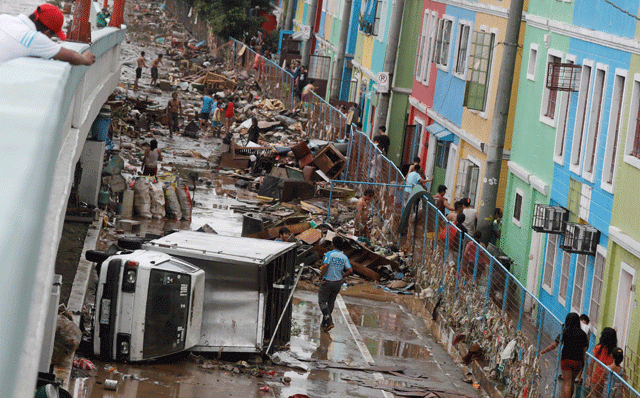
Online Filipinos called for an end of a so-called romanticization of resiliency during the rainy season as monsoon rains pummeled the metropolis over the weekend.
Many voiced their opposition to the underscoring of Filipinos’ “resiliency” as floods covered the streets, complaining that the narrative was an undue substitute for assessing the capability of local government units to provide services during the deluge.
Nag-Ondoy, nag-Yolanda. Resiliency pa rin yung highlight natin? How about assessing how LGUs have prepared for disasters like flooding? https://t.co/uK3dPpVwql
— #StandWithWorkers (@kristinamisajon) August 11, 2018
For some, the concept of “Filipino resiliency” broadcast during times calamity is only byproduct of the country’s battle with flooding.
We’ve been romanticizing resiliency of the Filipino people for the past decades.
Actually, our resiliency may be a good excuse of government’s inaction.
We need real and sustainable solutions now.
Photos from the FB page of ‘History & Trivia Philippines World.’ pic.twitter.com/0wjvhxD6aA
— Jules Guiang ?? (@JULESguiang) August 13, 2018
For others, the narrative has also masked the severity of the country’s struggle with disaster preparedness.
let's put an end to "resilience".
it's what prevents us from recognizing our status as victims.
— florin hilbay (@fthilbay) August 13, 2018
This year’s monsoon rains have been compared to Typhoon Ondoy, the powerful cyclone that left 464 people dead and P6-billion worth of damage in the Philippines in September 2009.
At least three people died during the intense rains over the weekend.
About 24,000 Metro Manila residents are reportedly still in evacuation centers as of Monday afternoon. The number reached 30,000 hours earlier.
Several areas in Metro Manila were submerged in water, with riverside and coastal areas suffering the most.
In Marikina City, vehicles near the Marikina River were submerged and buildings were flooded after the rains caused water levels to rise.
Roxas Boulevard, meanwhile, saw tons of garbage washed ashore as massive waves regurgitated waste from the sea.
Problems and solutions in disaster resiliency
The government’s allocated budget for disaster management has taken a beating in recent years.
Congress reduced President Rodrigo Duterte’s proposed P30.7-billion national disaster risk reduction and management fund to P19.6 billion in December 2017.
The group Social Watch Philippines previously decried cuts in the funding of the National Disaster Risk Reduction and Management Council and the Office of Civil Defense, agencies tasked with disaster management.
The group questioned why the NDRRMC’s budget was cut down from P38.9 billion to P15.7 billion in 2016.
Civil Defense’s budget, on the one hand, was slashed from P1 billion to a mere P481 million.
Rep. Joey Salceda (Albay) in July 2018 filed a bill creating a new agency for disaster management.
The proposed “Department of Disaster Resilience” will have an initial budget of P10 billion and will introduce a more strategic approach to disaster prevention and mitigation.
Salceda said that he filed the bill to answer the president’s calls for better disaster prevention in his 2017 State of the Nation Address.









